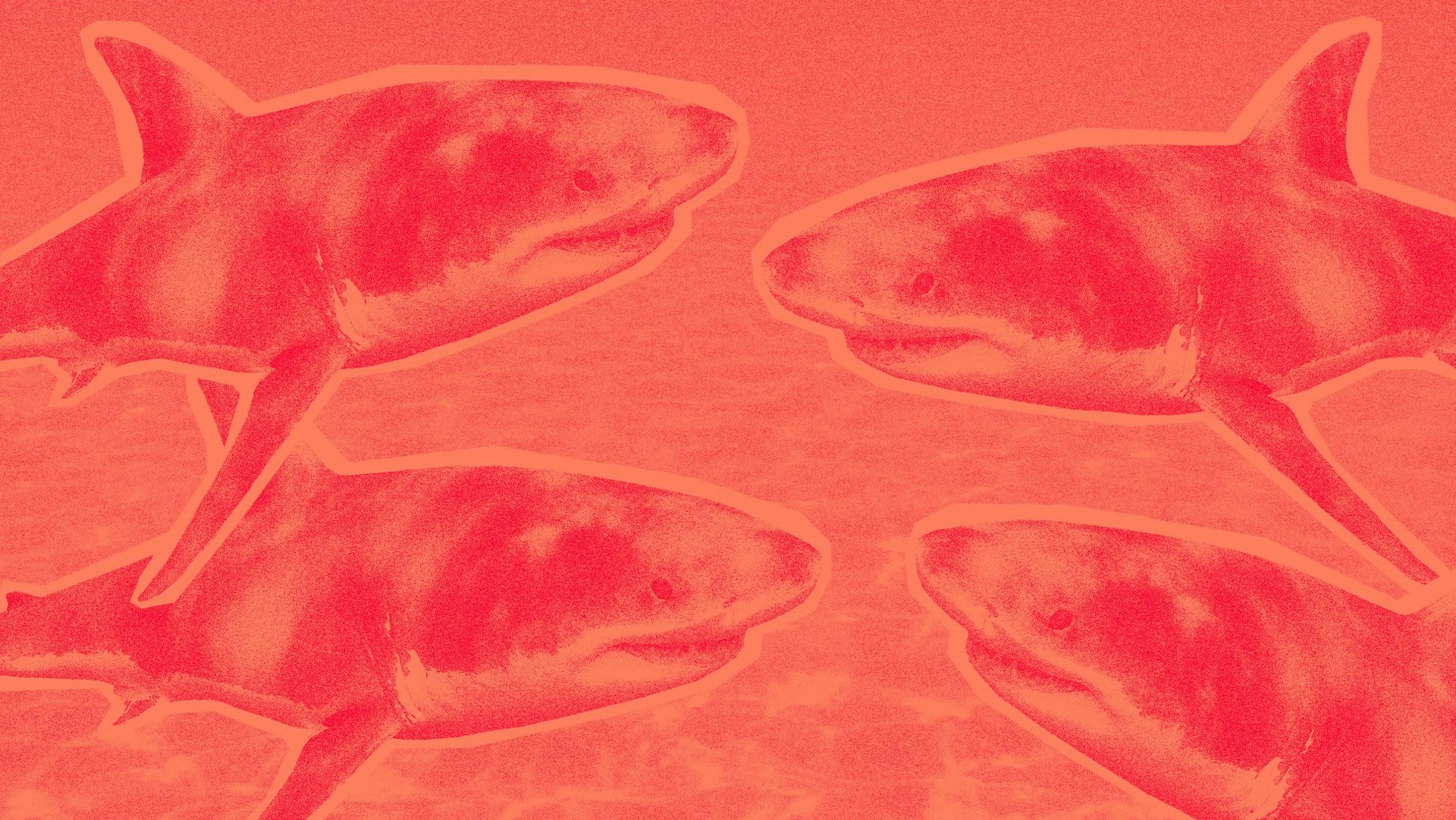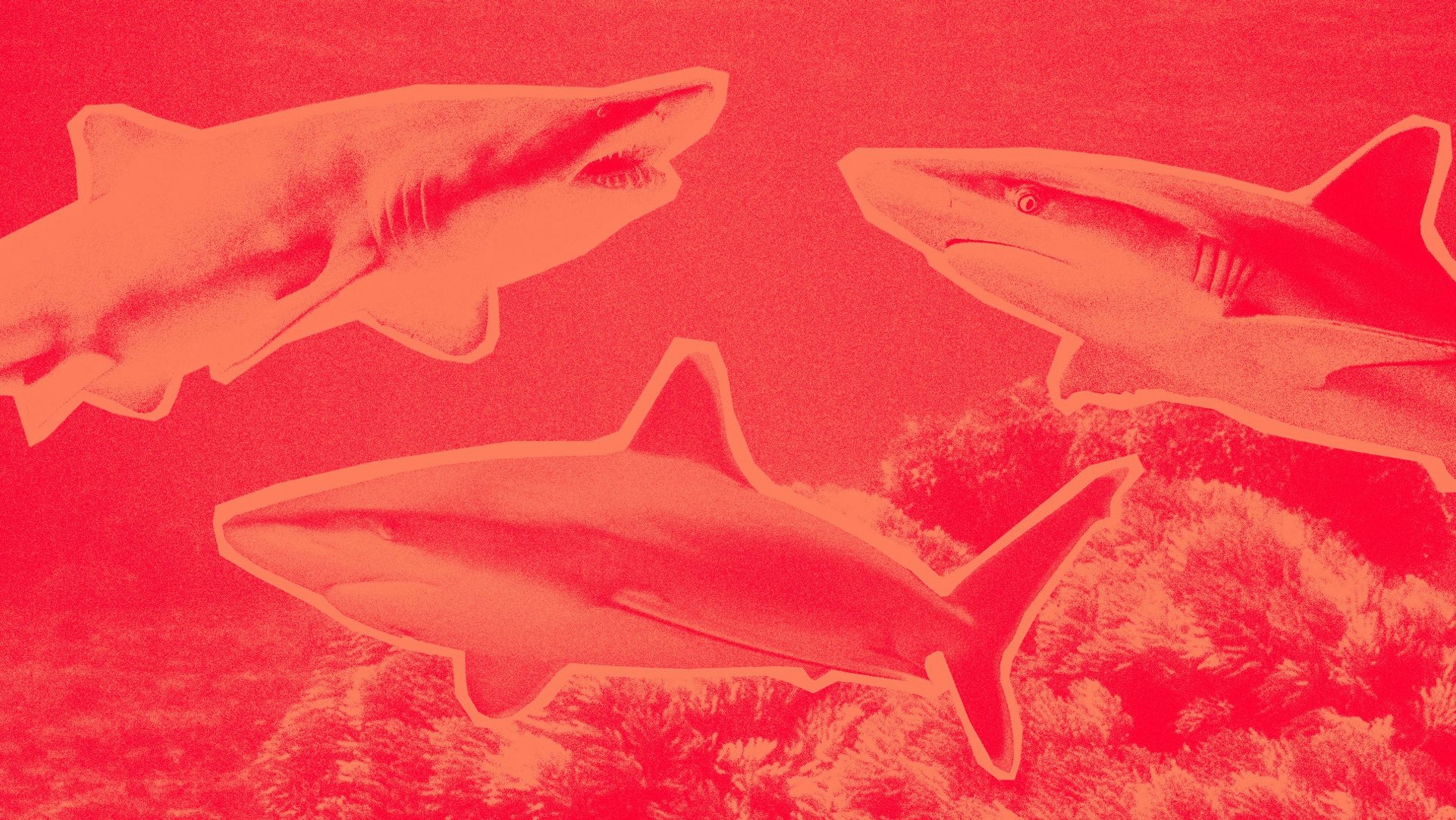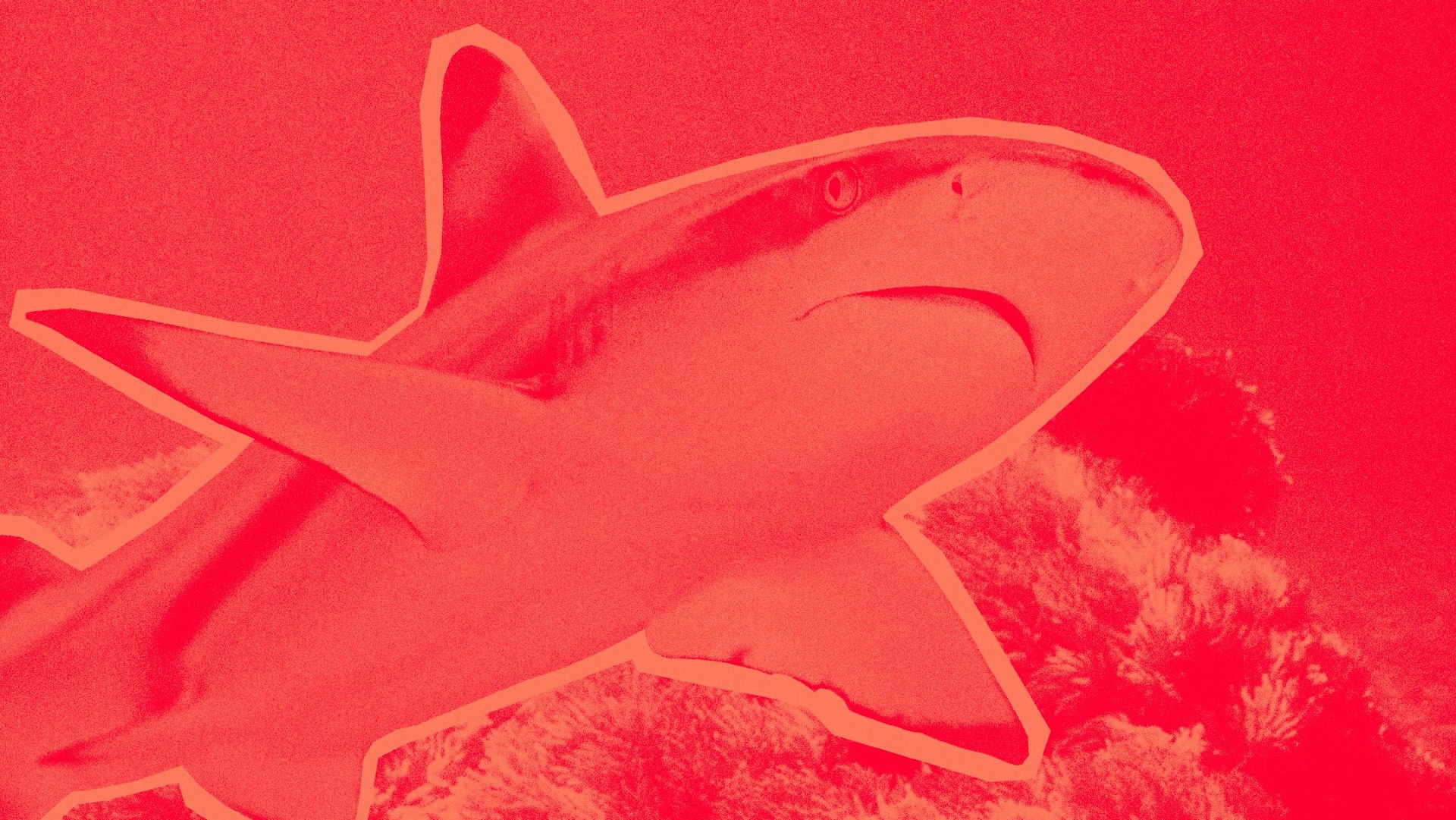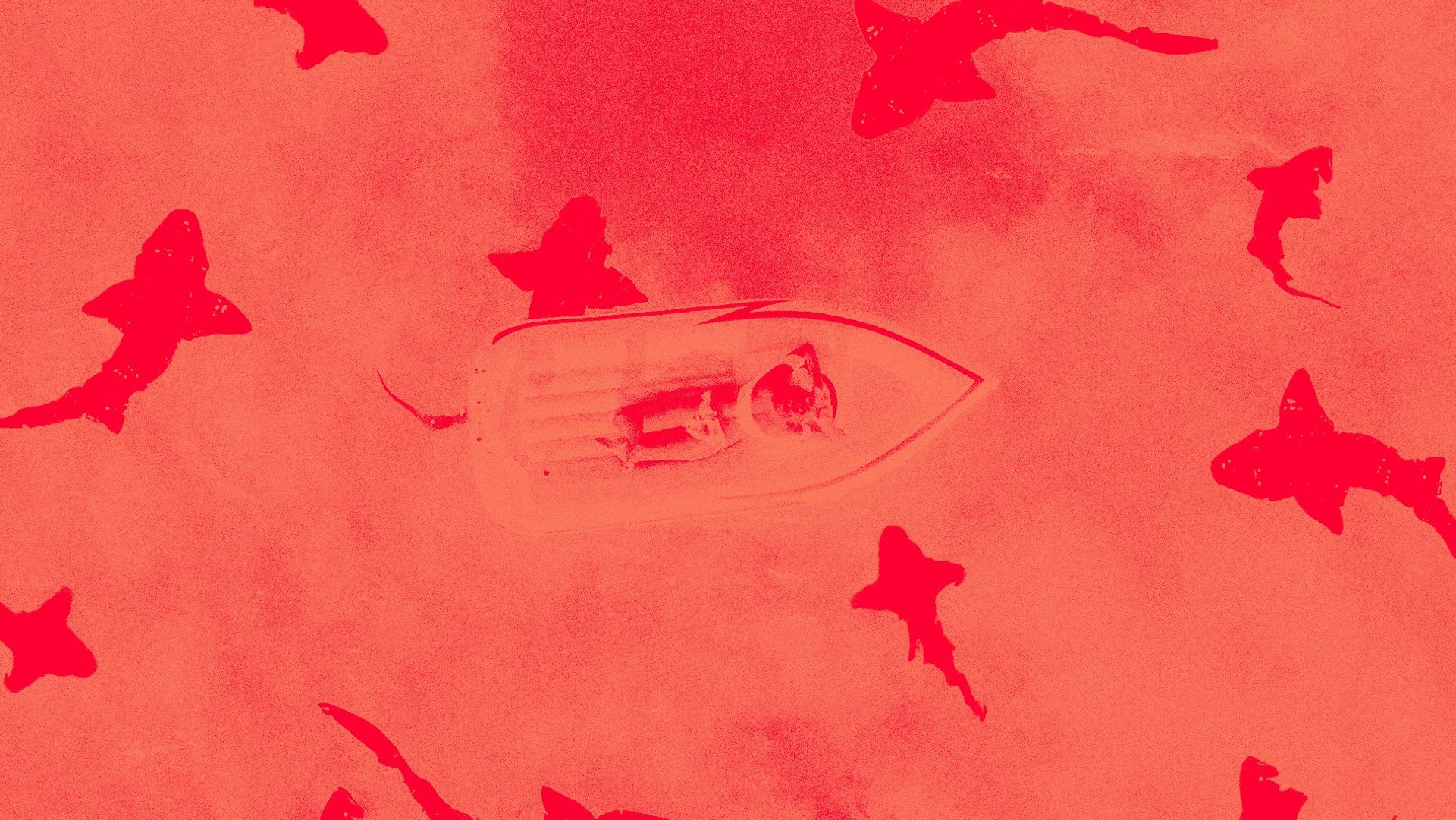
Unlocking the killer myths behind our fear of sharks
- Text by Miles Masterson
- Illustrations by Emma Balebela
This story first appeared in Huck Issue 16 (2009). During lockdown, we’ll be republishing longreads from the print archive to help keep you occupied during the long days indoors.
Sharks. Conjure up, if you will, a world without them. It seems hard to do. Even if you have never swum in the ocean, you’ll be aware of their killer instinct. You’ll be able to visualise your spilled blood, colouring the water around you crimson, as the shark’s scythe-like grill sinks into your soft edible flesh. You can imagine the excruciating agony as those rows of impossibly sharp teeth clamp down and slice into your limbs or torso; envisage your own mad panic as those cold, unfeeling eyes bore into your soul, and sense the plunge of despair as the beast, thrashing around like a deranged gothic monster, unleashes its magnetic, prehistoric power and pulls you under the surface to a manifestly painful, lonely doom.
—
I have a friend who won’t surf at a certain beach. He’s resolute. Miles long, and covered in acres of crispy bleach-white dunes, it has the best sandbars within a half day’s drive, arguably among the finest in the world. Epic A-frame peaks, to rival Hossegor’s La Gravière, offer tube rides up to ten seconds long. But he simply won’t surf it. You won’t catch him dead there, he says.
Why? Because the beach, at Noordhoek in Cape Town, South Africa, has been the location of a frightening number of great white shark attacks and close calls. Most notably, a fatal one on a nineteen-year-old Capetonian bodyboarder, David Bornman, who in 2003 was taken across the chest and stomach and bled to death in minutes, as his distraught fellows tried to gather his intestines on the shore. And another in 2005, when a British surfer, Plymouth school teacher Chris Sullivan, was bitten on the ankle and, hanging by a ligament onto life, was fortunate enough to be airlifted to a nearby hospital for a life-saving blood transfusion.
Though the local authorities limply banned surfing here for a few weeks following the two incidents, these days more than one hundred surfers can still be seen at the wave on a Saturday afternoon. But not my mate. And he’s not alone. Many Cape Town surfers won’t go near the place.
—
The fear of sharks – selachophobia or, more popularly, galeophobia – is an irrational dread that manifests itself as uncontrollable anxiety. Many humans who will never set foot in the sea have an inexplicable tendency to urinate involuntarily in response to the always-evocative word. Say, ‘Shark!’ (better yet, shout it on a crowded beach) and see the reactions. Terror. Screaming. Tears. Wee.
So the question begs: Why have humans always been so afraid of sharks? It’s not as if most folk, besides surfers and divers perhaps, will ever encounter one in its natural habitat. Shark experts will reiterate that almost all attacks on humans are due to them mistaking us for natural prey. Number nerds will confirm that you have considerably more chance of meeting your maker digging for a lost crust in your toaster. “People get sick of statistics, but we know through science that sharks are not targeting us,” says Alison Kock, chief biologist at the South African Save Our Seas Shark Institute.
Unsurprisingly, it is Peter Benchley’s notorious novel and subsequent blockbuster movie franchise, Jaws, that is widely regarded as being responsible for most modern shark prejudice. “Jaws very cleverly touched on three basic fear patterns,” agrees UK shark expert Richard Peirce, Chairman of the Shark Trust UK. “The fear of being out of your natural element, so you haven’t got your feet on land; the fear of the unknown, the fact your feet are dangling; and the fear of being eaten alive… and that film hit all three of those buttons in the first two minutes.”
Peirce is a vocal critic of the way the media – daily newspapers especially – portray sharks. Tabloid headlines blast the five-letter noun at us in 80-point type whenever there is an attack or – as was the case in Cornwall, England – alleged sightings of great whites. Peirce says that thanks in part to the negative publicity in movies and newsprint, our mindset towards sharks is very different to the one we have in relation to land-based predators, such as alligators, hippos or big cats. “We have this kind of weird thinking that we might be able to outrun [land-based predators], but unfortunately with sharks this ain’t the case,” he says. “But I honestly believe this irrational fear of sharks in many cultures goes way back before Jaws, and they just capitalised on it.”

The ancient Greeks of 600 to 300 BC were among the first to contribute significantly to both nascent shark lore and documented shark science. Like most classical stories, many of which are referenced in the Dictionary of Roman and Greek Biography and Mythology, the origins of their fables are often contradictory. Yet, considering the fact that many larger species, including blue and white sharks, would have been plentiful in the region at the time, they may well have seemed supernatural enough for the early Greeks to demonise. “The source of many of these fantastical tales could have been sharks,” agrees Marina Pearson, a South African classics scholar, “as whales, octopuses and mythical monsters were widely feared.”
Several of the most enduring Greek gods hail from the ocean – Poseidon, the god of the sea, the Tritons, Oceanus – but there are many lesser-known tales, such as that of the Daimon Goddess Lamia, probable daughter of Poseidon and muse of Zeus, who is said to have lost her children to Zeus’ jealous wife Hera. In revenge, Lamia turned to snatching, murdering and eating children, her evil actions causing her appearance to morph into that of a shark-like creature with great teeth, according to some texts.
Another legend tells of Zeus bestowing Lamia with the curious ability to remove and replace her eyes at will. It is interesting to note that, as a protective measure, blue sharks have a nictitating membrane which covers their eyes, and white sharks similarly roll their eyes back into their head during feeding or an attack, which may or may not be a telling coincidence. Scylla, who is believed to be Lamia’s daughter, was reputed to have further shark connotations. She was a bloodthirsty sea monster who had between three and six heads of various sharp-toothed animals and inhabited the treacherous strait of Messina just off the southern coast of Italy, where she devoured hapless sailors.
Scientifically, in the fourth century BC, the Greek philosopher and zoologist Aristotle was the first to distinguish rays and sharks – //selachii// as he termed them – as cartilaginous species separate from bony fish. He noted and described that the young of the ‘dogfish’ (the word ‘shark’ had yet to be coined) are linked to the womb by a navel cord and placenta, much as in a mammal. “Nothing has contributed more to Aristotle’s modern scientific reputation than the rediscovery of this in the 18th century,” notes the //Oxford Classical Dictionary//.
—
Sharks also appear in the verbal history and superstitions of scores of other cultures throughout the world, from the Australian Aboriginals to the South African Xhosa tribes. Unlike the early Greeks, their perspectives towards sharks were not necessarily based on a fear of ‘monsters’, but rather on respect for the inherent power of these predators, often depicted on pottery and tribal emblems. Shark teeth have been found in ruins of the Aztec and Inca cultures, and throughout Central America, the Caribbean and the middens of North American Native Indians as far inland as Illinois. “White and bull shark teeth with their triangular shape and serrated edges held value in trade as well as presumably some spiritual significance in ceremonial use,” says George Burgess, a leading US shark academic and director of the International Shark Attack File.
Many cultures, he adds, have used shark teeth in one manner or another, notably in weapons, where their power was thought to transfer to the warrior. Sharks, continues Burgess, were admired and revered as deities throughout the Oceania region of the Pacific. Polynesian societies incorporated them into their mythology, and the Hawaiians have a rich history of association with sharks, with shape-shifting shark men, sporting shark jaws on their backs, warning people when there was danger in the water. Shark gods were also believed to be custodians of the sea, known as Amakua.
In the Triobrand Islands of the Solomon Sea and among the Maoris of New Zealand sharks were similarly held in high esteem. Like many other Pacific islanders, people here shared the widespread belief that sharks were not harmful and in some places, such as Fiji, catching and eating them was even prohibited by royal decree.
 Europeans held an entirely different view of sharks. Though historical references to shark-like creatures after the classic civilisations are sporadic, as most of the continent entered a period of warfare and cultural regression, shark tales resume with a vengeance at the end of the Middle Ages, when exploration became de rigueur once again. As South African shark hunter Theo Ferreira puts it: “Ever since the 17th century, the only good shark was a dead shark.”
Europeans held an entirely different view of sharks. Though historical references to shark-like creatures after the classic civilisations are sporadic, as most of the continent entered a period of warfare and cultural regression, shark tales resume with a vengeance at the end of the Middle Ages, when exploration became de rigueur once again. As South African shark hunter Theo Ferreira puts it: “Ever since the 17th century, the only good shark was a dead shark.”
In his book The Shadow Below, author and shark historian Hugh Edward refers to the writings of European traveller Samuel Purchas of 1617 regarding Hindu pilgrims on the Indian subcontinent, who cast themselves to ‘sea dogs’ in the Ganges as a fast track to paradise (these were conceivably bull sharks, still found in the river today, although in far fewer numbers). Notably, the god Vishnu is often depicted coming out of a creature believed by many scholars to be a shark.
“Just as some say vultures recognise the presence of a corpse by its smell, many leagues away, so some believe that sharks have the same divinatory power.” So wrote Ferdinand Columbus of an encounter on one of his father Christopher’s earliest voyages to the West Indies in the early 1500s. Zoologist Thomas Pennant similarly documented the supposed lust of great white sharks for human flesh. “They are the dread of sailors,” he wrote in 1776, “they constantly attend the ships in expectation of what may drop overboard; a man that has that misfortune perishes without redemption.”
Thanks to descriptions like this and the fantastic and exaggerated tales of returning seamen, in Europe the public conception of sharks as monsters grew disproportionally. “When they saw a shark they didn’t see the shark you and I see today, they saw a monster of mythology,” concurs George Burgess. “An exchange of erroneous information passed on from one generation to another [of which] sharks are an unfortunate recipient to this day.”
Throughout this time sharks were depicted as savage beasts in art, such as John Singleton Copley’s painting Watson and the Shark, dated 1778. The shark also appears regularly in Western literature, and almost always in antagonistic fashion. Shakespeare refers to the “ravin’d salt-sea shark” in Macbeth and Herman Melville treated sharks similarly in Moby Dick, in which he notes their cannibalistic tendencies when wounded by whaler’s knives. “They viciously snapped not only at each other’s disembowelments but also at their own,” he wrote.
To add to the stigma, zoologists called the subspecies of mostly larger, predatory sharks (such as hammerhead and white sharks) ‘requiem’ sharks which, in the Roman Catholic Church, denotes the Mass for the repose of the dead. To this day negative connotations continue in rapacious terms such as ‘loan shark’ and ‘card shark’.
—
It was a shipwreck in 1852 that first brought the terror of a shark feeding frenzy into sharp focus when the British troopship The Birkenhead struck a rock off the South African coastline. Of the 680 people onboard, 455 died, most killed by sharks. “Hundreds of them were around us and I saw men taken quite close to me,” wrote one survivor, Lieutenant Frank Giradot. A similar tragedy occurred on the same coast nearly 100 years later, when the Nova Scotia, a British ship transporting Italian prisoners of war, was sunk by a German U-boat in 1942, leaving the survivors with an equally gory story.
But it is the USS Indianapolis that had the deepest effect on the perception of sharks – albeit with a telling twist. On July 30, 1945, having departed Guam, the ship was torpedoed by a Japanese submarine. Around 900 of the 1000-plus crew made it into the water but were left to float for five days in a bloodied sea before eventually being rescued. During this time sharks were believed to have killed almost two thirds of them.
The Shark Attack File’s George Burgess is a leading authority on the incident and has interviewed many of the survivors. He has another perspective, saying that, like many of these incidents, most of the feeding was actually post-mortem on drowned sailors. “It turns out there was a lot of distortion,” he explains, “and much of [it] was intentional. The captain of the Indianapolis was court-martialled for what happened… much to the chagrin of his crew […] I was told by survivors that [they] often clearly overstated the shark situation as an indication of how the captain had saved their lives.”
Unfortunately, by then the fate of the crew had been widely reported and the damage to the shark’s reputation was done. But sharks had already been a favoured headline to sell newspapers in the US from the turn of the century, best exemplified by a spate of attacks in the state of New Jersey in the summer of 1916 when, in just under two weeks, five attacks occurred along the coast (two in a river), resulting in four deaths. Whilst there is still some disagreement among scientists whether the attacks were all by one shark, and whether it was a white or bull shark, newspaper headlines featured mad hyperbole, such as ‘Jersey Man-Eater’ and ‘12 Days of Terror’.
 “This set the tone for the era and why things were primed for a panic,” says Burgess. “The attacks occurred in New Jersey, which was close to the cultural epicentres of New York, Philadelphia and Washington DC and at the time that’s where the major media were in the United States.” These beaches were of course closed and most resorts, all too aware that they would lose vital tourism dollars, petitioned the federal government to protect bathers, instigating shark hunts and preventative measures such as crude steel mesh nets and armed shark patrols.
“This set the tone for the era and why things were primed for a panic,” says Burgess. “The attacks occurred in New Jersey, which was close to the cultural epicentres of New York, Philadelphia and Washington DC and at the time that’s where the major media were in the United States.” These beaches were of course closed and most resorts, all too aware that they would lose vital tourism dollars, petitioned the federal government to protect bathers, instigating shark hunts and preventative measures such as crude steel mesh nets and armed shark patrols.
If the story sounds similar to Jaws, that’s because the NJ attacks inspired Peter Benchley to pen his novel some sixty years later. But long before Jaws could spread its own special brand of shark hysteria, similar scenarios unfolded as attacks continued, feeding the growing fear of sharks, especially great whites, around the world. Before and in-between the world wars, attacks and media reporting in Australia had increased shark awareness and with it fear. Two incidents in particular in Western Australia between 1923 and 1925 provoked a public reaction that resulted in the construction of protected swimming areas and, though they did not survive winter storms, more rudimentary shark nets.
Meanwhile, sharks pervaded the minds of those living or holidaying near the sea in South Africa. Intermittent attacks on people over the years, mostly in Durban (which had taken lead from Australia and installed vastly improved nets at its main beaches in the early 1950s), had kept sharks top of mind. But during the summer of 1957 this spilled over into paranoia reminiscent of New Jersey. During the so-called ‘Black December’ five attacks resulting in two deaths rocked a number of resorts in popular holiday destinations along the South Coast.
Another two attacks in April 1958 – one fatal on a mother of four as she waded in knee-deep water – exacerbated the panic. Authorities responded to public pressure by killing every swimming creature along the coast with depth charges and rifles in a spectacle that drew huge crowds. The attacks also meant that shark nets were installed at most of the beaches concerned. Back then, these were thought to be the ultimate solution, but as we now know, they indiscriminately kill many forms of sea life other than sharks.
The 1957/58 attacks in SA also inspired a number of shark fishermen to hunt the ‘evil beasts’. One of them was shark hunter Theo Ferreira, who first encountered a beached shark as an eleven-year-old boy on the South Coast that same summer. “I was excited,” he recalls. “I wanted to catch and conquer it, but I was also scared and my first instinct was to kill it. I was influenced by the shark folklore about these monsters… created by the hysteria of Black December.”
The ‘Killer Shark!’ myth had by then become accepted as fact worldwide. After one attack at a resort on the Adriatic Sea, the government of Yugoslavia placed a bounty on sharks. With strong public support, shark hunters such as Ferreira and his Australian equivalent Vic Hislop (a.k.a. ‘The Shark Man’) caught and killed thousands of sharks. The most famous shark hunter ever though was probably the character named Quint, played by Robert Shaw in Jaws. A grizzled, bitter fictional survivor of the Indianapolis, he was the perfect depiction of their devotion to their murderous cause. The movie and sequels (as well as numerous pretenders) fuelled the denigration of sharks in the public eye to the point where author Peter Benchley later admitted that he may well have inadvertently caused the death of more sharks than anyone.
However, in the early eighties, when it was starting to become obvious to scientists that shark numbers were beginning to decrease, many did a sudden about turn. Benchley, Hislop and Ferreira, among others, became vocal shark conservationists. Ferreira tells how he had an epiphany when he was hunting a female great white that simply refused to die and realised sharks were really magnificent creatures. “I can’t believe we were that stupid,” he says. “I thought I was doing mankind a serious service by ridding the ocean of these man-eaters and I thought I was a hero.” Benchley is quoted as saying before his death in 2006: “If I had known then what I know now about sharks, I would not have been able to write Jaws.”
 Thanks to the efforts of Ferreira and other local conservationists, South Africa became the first country to list great white sharks as a protected species in 1991. Since then, white sharks and other species have been protected in many nations. Yet, as attacks by great whites and other sharks continued through the nineties and into the naughties, much of the media – newspapers and websites mainly, but also books, documentaries and Hollywood films – maintained their sensationalist approach.
Thanks to the efforts of Ferreira and other local conservationists, South Africa became the first country to list great white sharks as a protected species in 1991. Since then, white sharks and other species have been protected in many nations. Yet, as attacks by great whites and other sharks continued through the nineties and into the naughties, much of the media – newspapers and websites mainly, but also books, documentaries and Hollywood films – maintained their sensationalist approach.
This kind of publicity has long irked Alison Kock of Save Our Seas. “It is very frustrating,” the conservationist says from behind her small desk in a cramped office at the institute’s Cape Town HQ. “It blows my mind how when there is a shark attack the newspapers will still be running the story two weeks later. Even wildlife documentaries are often inaccurate. I’ve personally been involved in scripts that have been sent to me to fact check and told them, ‘Look, this is completely wrong, we know this isn’t true anymore,’ but it doesn’t make it as interesting, so they leave it in.”
Perhaps one of the most obvious cases of media shark hype gone crazy took place in the United Kingdom in 2007, when The Sun printed a huge headline claiming that a great white shark had been spotted in the waters off St Ives, Cornwall. “I did battle with them all summer,” says Richard Peirce, “and that story resulted in an 18 per cent increase in the quietest month of the year for the newspaper, which is a big increase for a circulation of 3.2 million.” Though the supposed great white was actually a harmless basking shark, Peirce cites this incident as a prime example of how newspapers use sharks to sell more copies. “It is not news that an elephant lives in the jungle, or was spotted in Africa, but a shark is spotted in the sea off Cornwall and it is news?” he says vehemently. “Well, where do you expect it to be, on the top of a building? But it goes back to this extraordinary fascination that sharks have… they sort of send a shiver up the spine and it is very hard to remove this from the psyche of people.”
To The Sun’s credit, Peirce continues, they ran a shark conservation article recently and earlier this year the paper declined to print a fuzzy photo of an alleged white shark taken off Bournemouth, which, like the 2007 case, turned out to be a basking shark. “Now I was really impressed with that, two years ago they would have got away with it being a white shark, so maybe a degree of responsibility is creeping in. We’ve all worked very hard at it, so it might be.”
Alison Kock has also seen a notable shift in public and media attitudes towards sharks in recent years. Like many similar initiatives in places such as the UK, the US and Australia, Save Our Sharks concentrates on education around the plight of sharks. Last year they launched their Rethink the Shark advertising campaign, which featured among other things a toaster floating in the ocean, making a clever statistical point. SOS are also involved in the ‘Sharkspotting’ programme, which places unemployed people on the high crags above some of Cape Town’s surf spots to sound an alarm when they see a shark moving in. “From 2004, there has been a huge change in how people see sharks and how they have accepted that they are here,” adds Alison.
 While most people might acknowledge that the threat of a shark attack is not as great as they once thought, conservationists are still up against a host of other obstacles – including parents dropping their offspring at the beach for surf lessons or lifesaving on a Saturday morning. “It’s often those parents that are looking for something to protect their kids in the water,” notes Kock. South Africa has the most shark nets in the world (and with Australia is the only country to still use them). It’s down to the public, says Alison, to apply pressure on authorities to get nets removed by joining relevant organisations and signing petitions for the protection of shark species.
While most people might acknowledge that the threat of a shark attack is not as great as they once thought, conservationists are still up against a host of other obstacles – including parents dropping their offspring at the beach for surf lessons or lifesaving on a Saturday morning. “It’s often those parents that are looking for something to protect their kids in the water,” notes Kock. South Africa has the most shark nets in the world (and with Australia is the only country to still use them). It’s down to the public, says Alison, to apply pressure on authorities to get nets removed by joining relevant organisations and signing petitions for the protection of shark species.
Richard Peirce in turn advises that individuals should also refrain from purchasing teeth, jaws etc – and, he laughs, newspapers with glaring shark headlines. As for the controversial shark cage diving industry – thought by many to be the reason for recent attacks, thanks to sharks associating humans with food due to ‘chumming’ with blood and bait – many shark conservationists, including Kock and Peirce, are supportive. Properly run by legitimate operators, they say, cage diving plays a vital role in bringing revenue to coastal towns as well as educating people that sharks are incredible, reticent creatures worth preserving.
Ironically, it could be human consumption of sharks that will decide their ultimate fate. Though superstition and antipathy towards sharks continues to pervade their thinking, western fishermen are catching all kinds of species, mainly to bolster their income in the face of ever-dwindling fish stocks.
Most of this exploitation is due to the high premium placed on shark fins. In places such as the Middle East, India and Japan, Killer Shark mythology persists – much like in the West – and shark products are revered for, among other things, aphrodisiac qualities. But it is Hong Kong and China, where there is a massive demand for shark fin soup, used primarily as a status symbol at weddings, who are most responsible for the sharp drop in shark numbers worldwide.
The disappearance of sharks from our oceans is not as unlikely as it might once have been. And if it were to happen, the repercussions would be far-reaching as, for example, world fish stocks could decline even further as lower-tier ocean predators swim into the shark’s void. “In many ways the shark is the poster child for the decline of the sea,” sums up George Burgess. “If this apex predator, which through 400 million years of evolution does kill humans, rightly or wrongly, is able to so readily be struck down by humans in less than 100 years, what does that say for the rest of the sea?”
This story first appeared in Huck 16. Subscribe here to make sure you never miss another issue.
Read more from the Huck archive, courtesy of the Lockdown Longread.
Enjoyed this article? Like Huck on Facebook or follow us on Twitter.
